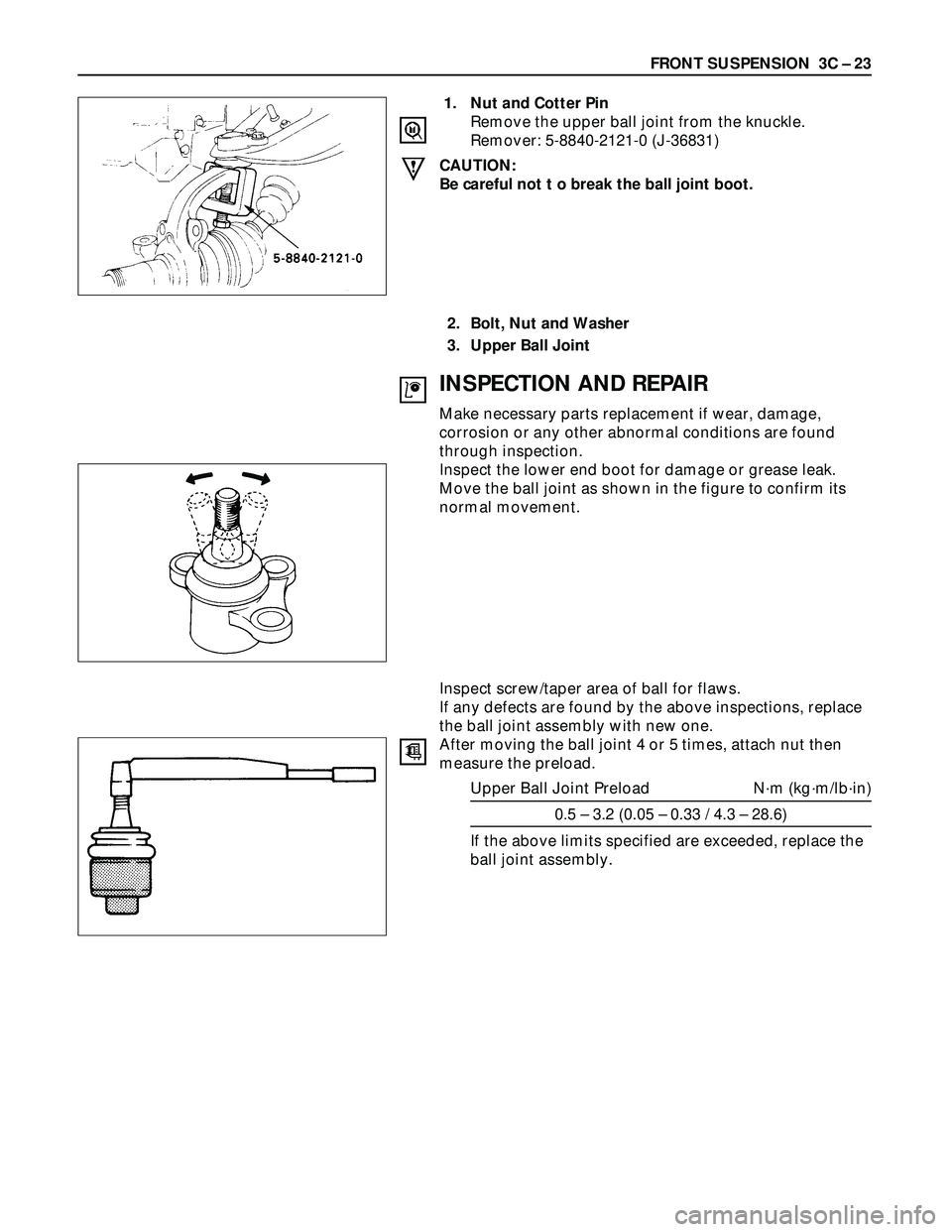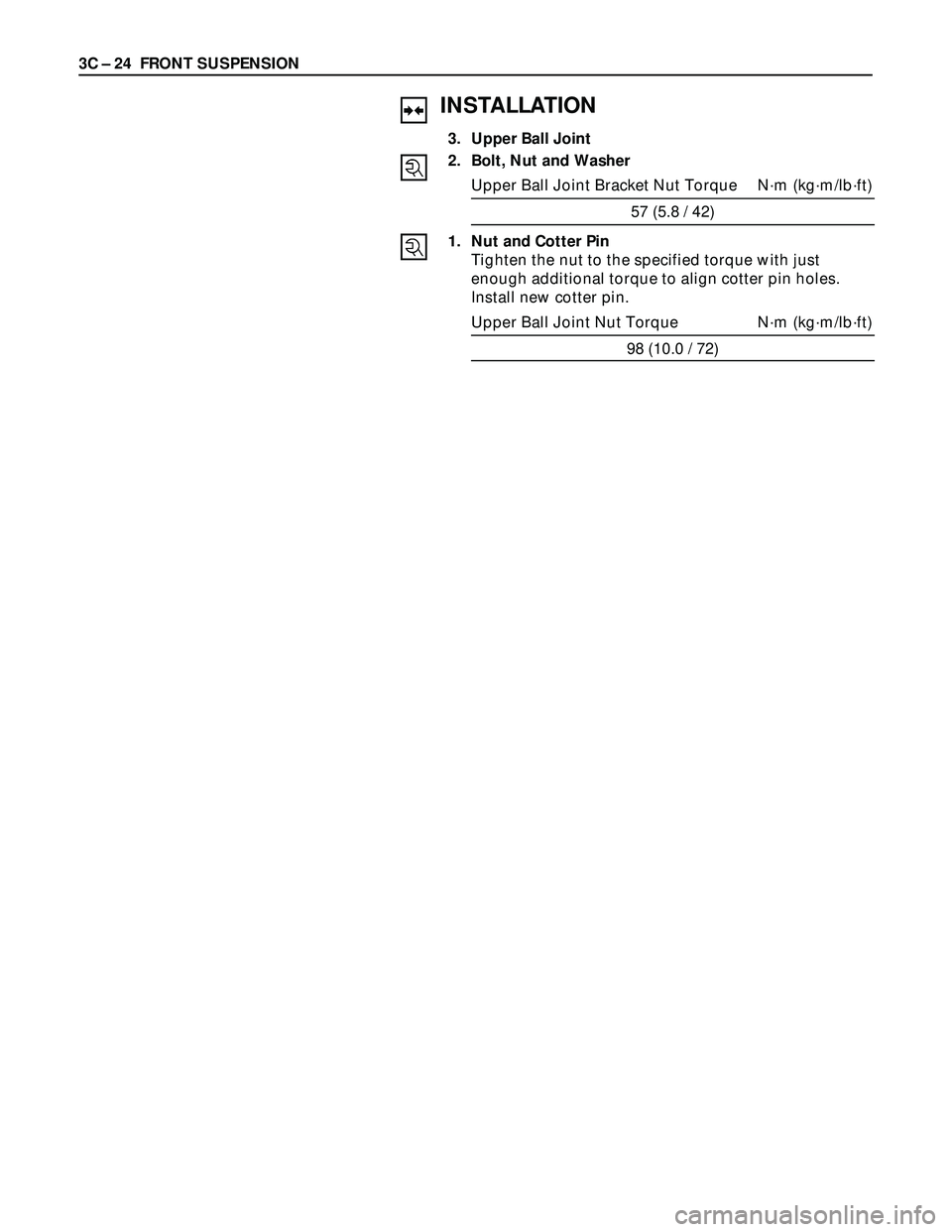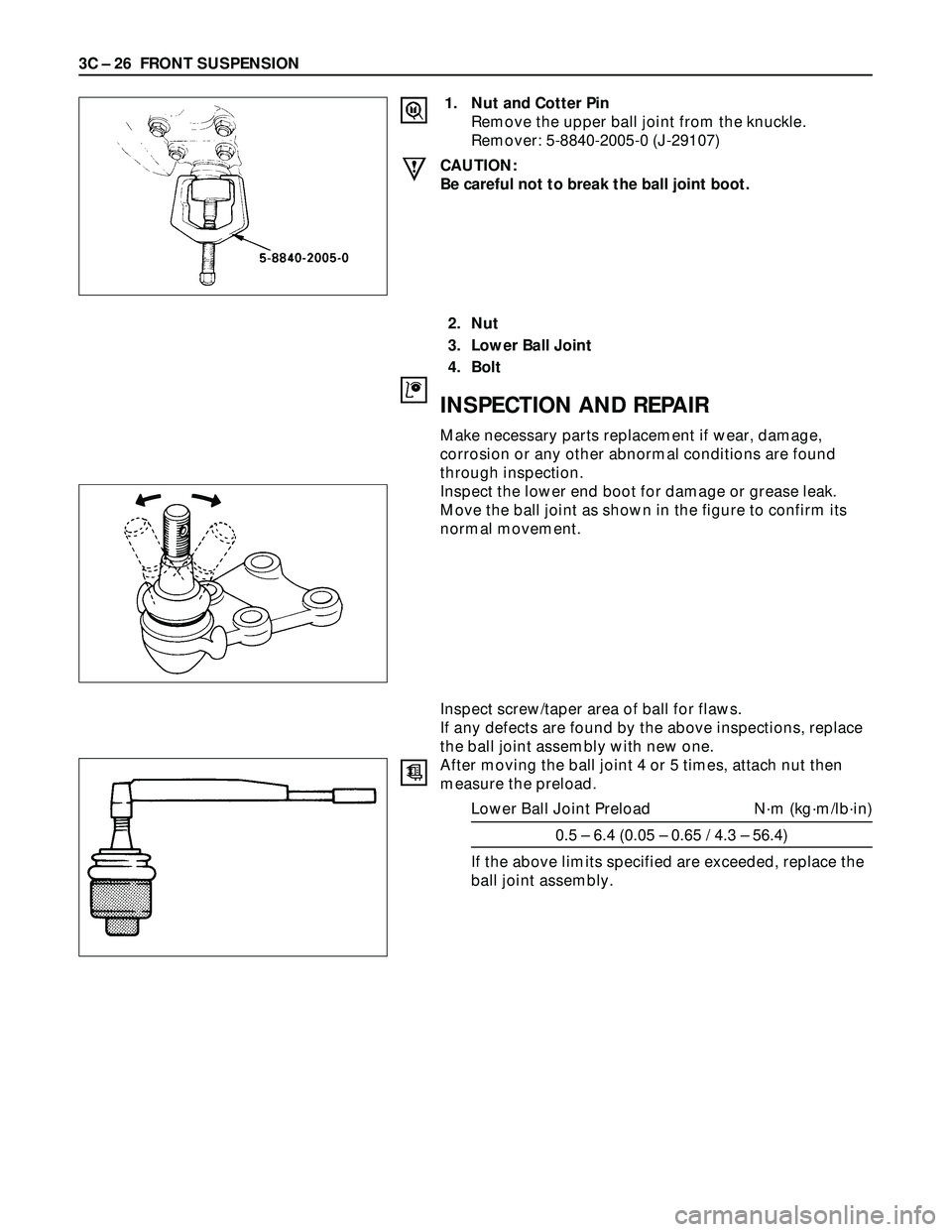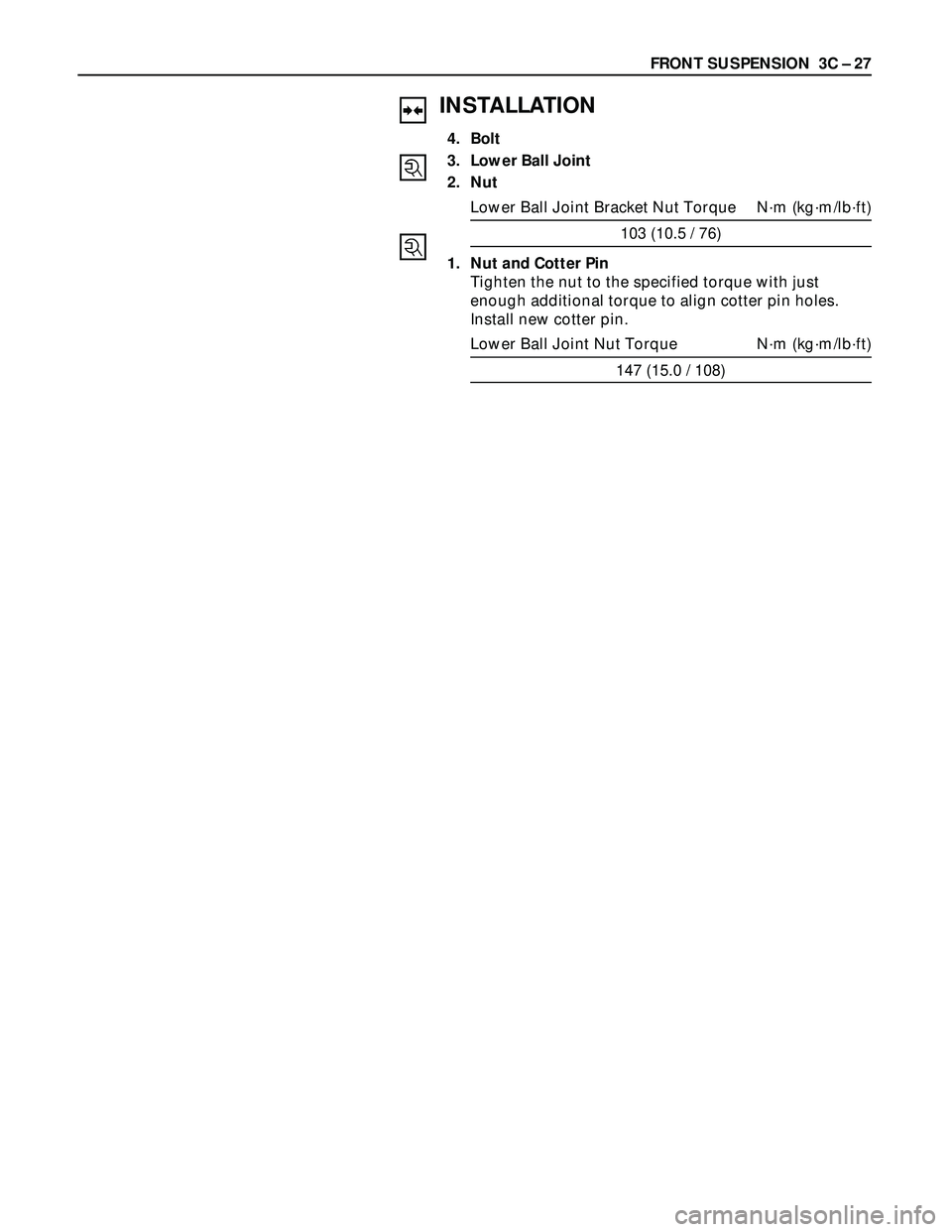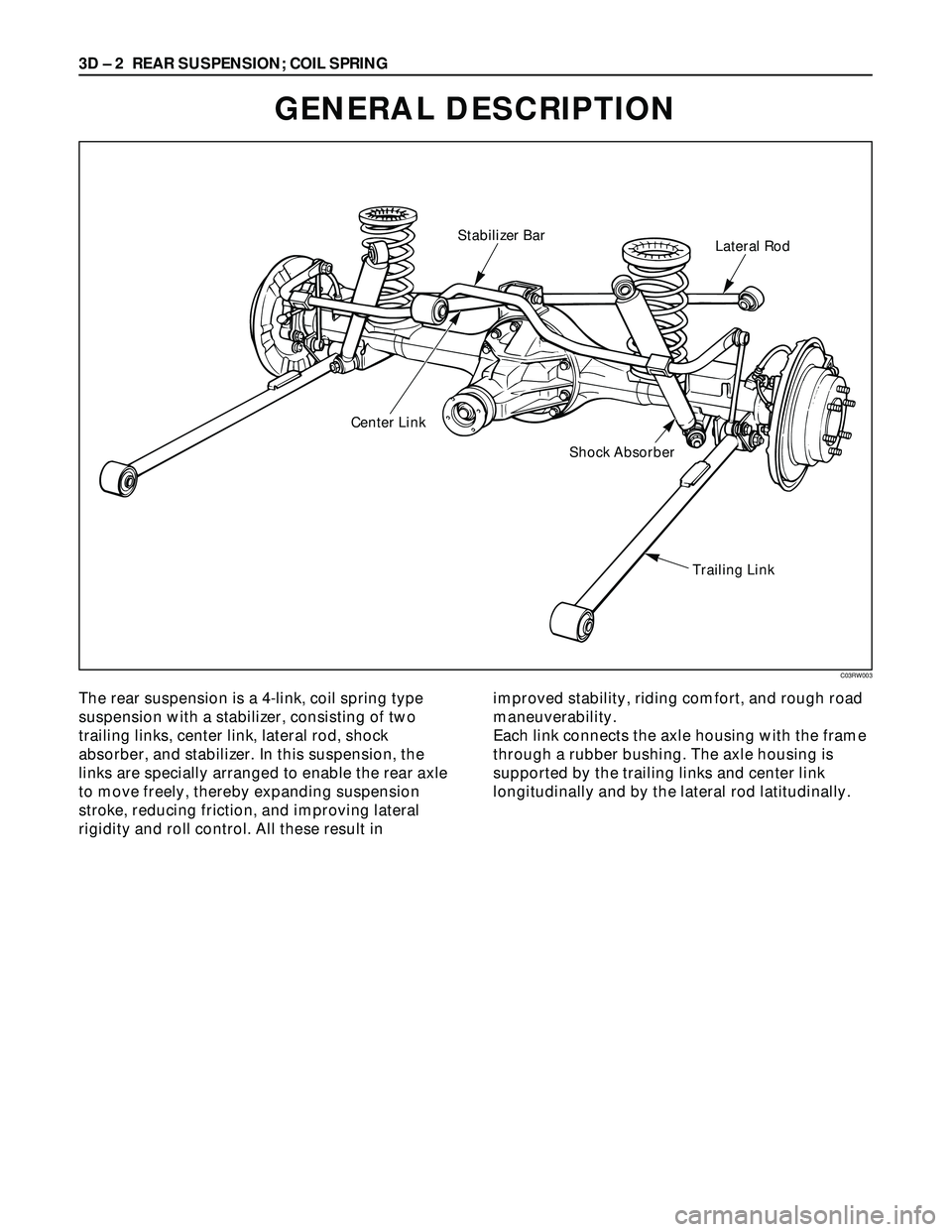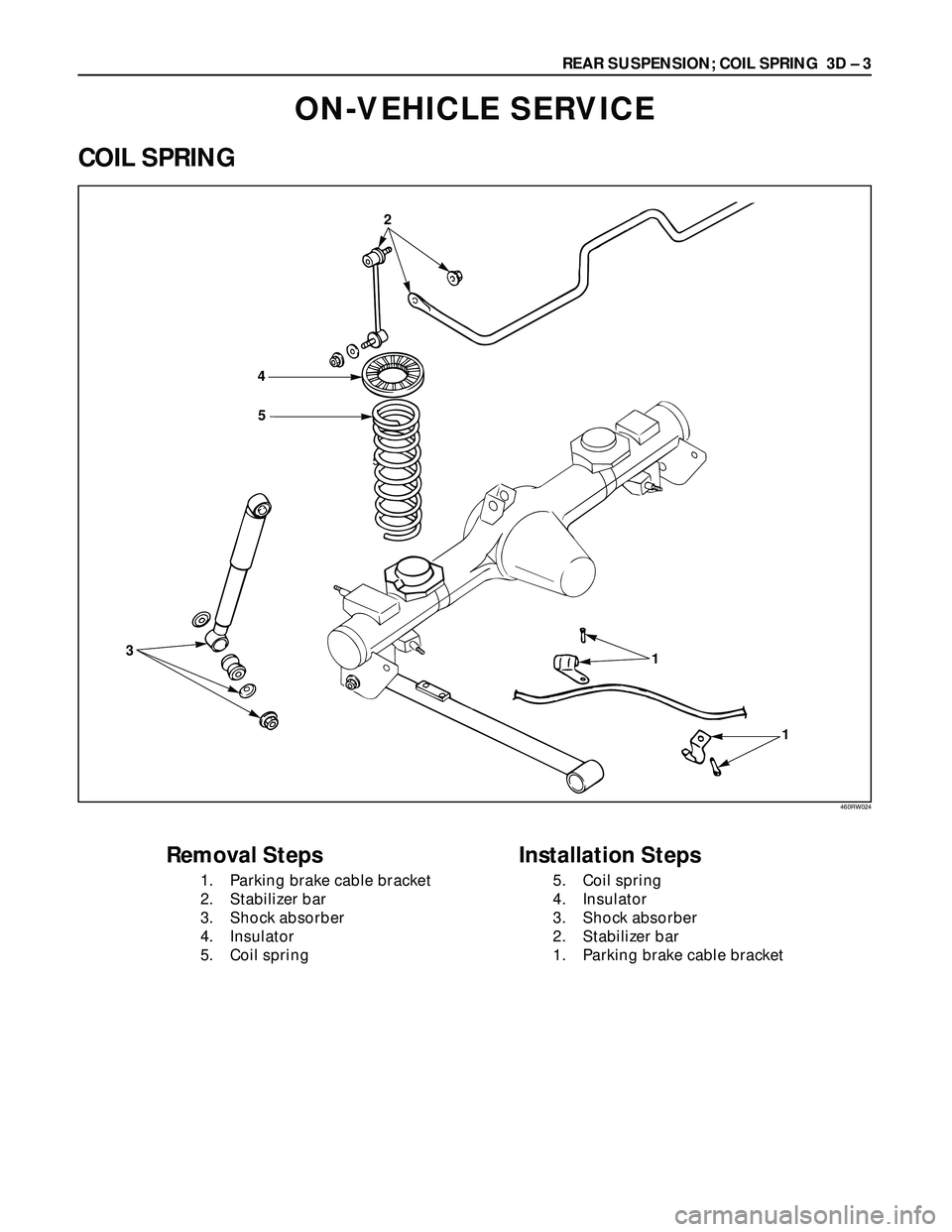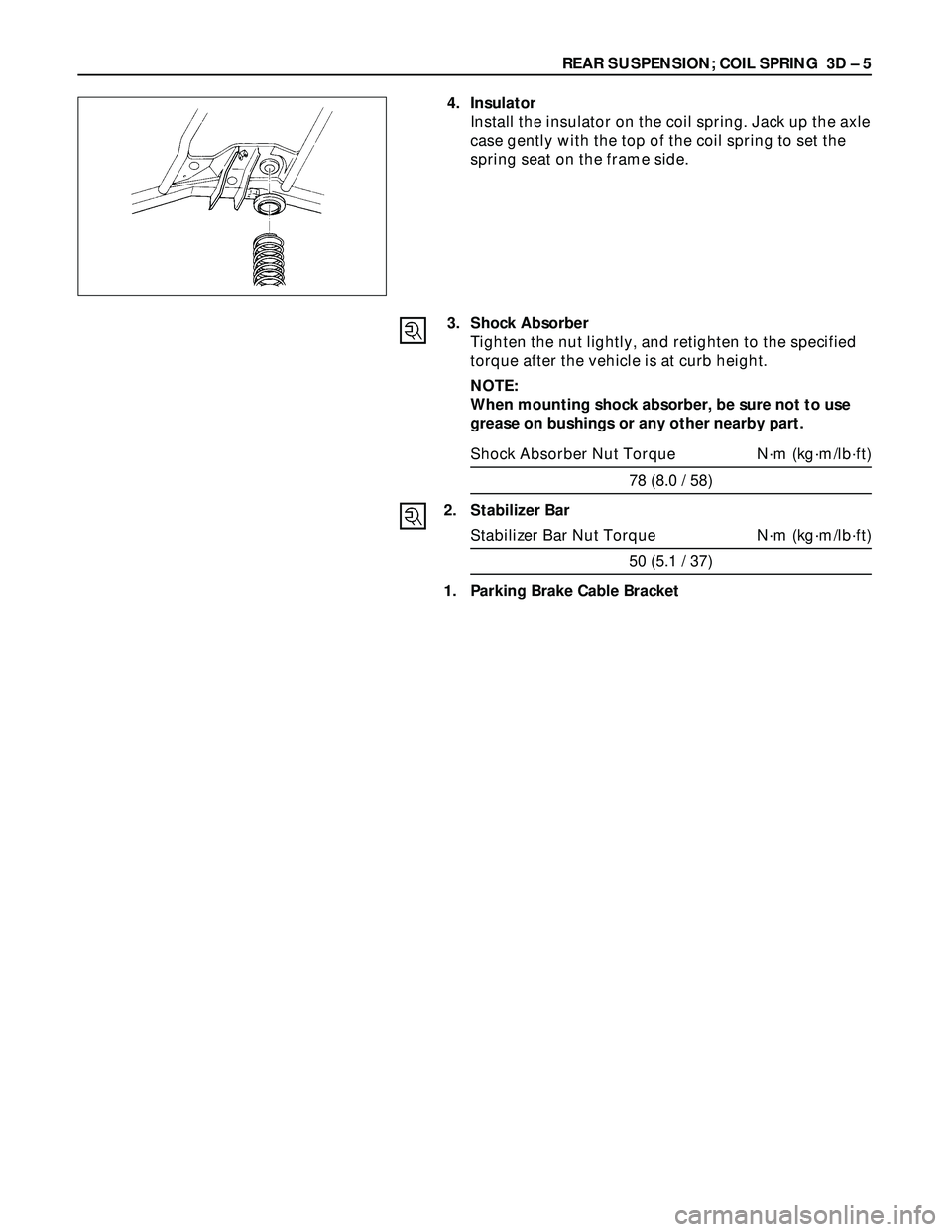ISUZU TROOPER 1998 Service Repair Manual
TROOPER 1998
ISUZU
ISUZU
https://www.carmanualsonline.info/img/61/57184/w960_57184-0.png
ISUZU TROOPER 1998 Service Repair Manual
Trending: fuel reserve, maintenance schedule, flex drive shaft, brake system diagram, trailer, oil level, 4WD
Page 411 of 3573
FRONT SUSPENSION 3C – 23
1. Nut and Cotter Pin
Remove the upper ball joint from the knuckle.
Remover: 5-8840-2121-0 (J-36831)
CAUTION:
Be careful not t o break the ball joint boot.
2. Bolt, Nut and Washer
3. Upper Ball Joint
INSPECTION AND REPAIR
Make necessary parts replacement if wear, damage,
corrosion or any other abnormal conditions are found
through inspection.
Inspect the lower end boot for damage or grease leak.
Move the ball joint as shown in the figure to confirm its
normal movement.
Inspect screw/taper area of ball for flaws.
If any defects are found by the above inspections, replace
the ball joint assembly with new one.
After moving the ball joint 4 or 5 times, attach nut then
measure the preload.
Upper Ball Joint Preload N·m (kg·m/lb·in)
0.5 – 3.2 (0.05 – 0.33 / 4.3 – 28.6)
If the above limits specified are exceeded, replace the
ball joint assembly.
Page 412 of 3573
3C – 24 FRONT SUSPENSION
INSTALLATION
3. Upper Ball Joint
2. Bolt, Nut and Washer
Upper Ball Joint Bracket Nut Torque N·m (kg·m/lb·ft)
57 (5.8 / 42)
1. Nut and Cotter Pin
Tighten the nut to the specified torque with just
enough additional torque to align cotter pin holes.
Install new cotter pin.
Upper Ball Joint Nut Torque N·m (kg·m/lb·ft)
98 (10.0 / 72)
Page 413 of 3573
FRONT SUSPENSION 3C – 25
LOWER BALL JOINT
Removal Steps
1. Nut and cotter pin
2. Nut
3. Lower ball joint
4. Bolt
Installation Steps
4. Bolt
3. Lower ball joint
2. Nut
1. Nut and cotter pin
REMOVAL
Preparation:
1) Raise the vehicle and support the frame with suitable
safety stands.
2) Remove wheel and tire assembly. Refer to “Wheels
and Tires” in section 3E.
3) Remove the outer track rod from the knuckle. Refer to
“Steering Linkage” in section 2A.
4) Remove the retaining ring from the front axle driving
shaft to release the shaft from hub. Refer to “Front
Axle” in section 4C.
5) Support lower control arm with a jack.
Page 414 of 3573
3C – 26 FRONT SUSPENSION
1. Nut and Cotter Pin
Remove the upper ball joint from the knuckle.
Remover: 5-8840-2005-0 (J-29107)
CAUTION:
Be careful not to break the ball joint boot.
2. Nut
3. Lower Ball Joint
4. Bolt
INSPECTION AND REPAIR
Make necessary parts replacement if wear, damage,
corrosion or any other abnormal conditions are found
through inspection.
Inspect the lower end boot for damage or grease leak.
Move the ball joint as shown in the figure to confirm its
normal movement.
Inspect screw/taper area of ball for flaws.
If any defects are found by the above inspections, replace
the ball joint assembly with new one.
After moving the ball joint 4 or 5 times, attach nut then
measure the preload.
Lower Ball Joint Preload N·m (kg·m/lb·in)
0.5 – 6.4 (0.05 – 0.65 / 4.3 – 56.4)
If the above limits specified are exceeded, replace the
ball joint assembly.
Page 415 of 3573
FRONT SUSPENSION 3C – 27
INSTALLATION
4. Bolt
3. Lower Ball Joint
2. Nut
Lower Ball Joint Bracket Nut Torque N·m (kg·m/lb·ft)
103 (10.5 / 76)
1. Nut and Cotter Pin
Tighten the nut to the specified torque with just
enough additional torque to align cotter pin holes.
Install new cotter pin.
Lower Ball Joint Nut Torque N·m (kg·m/lb·ft)
147 (15.0 / 108)
Page 416 of 3573
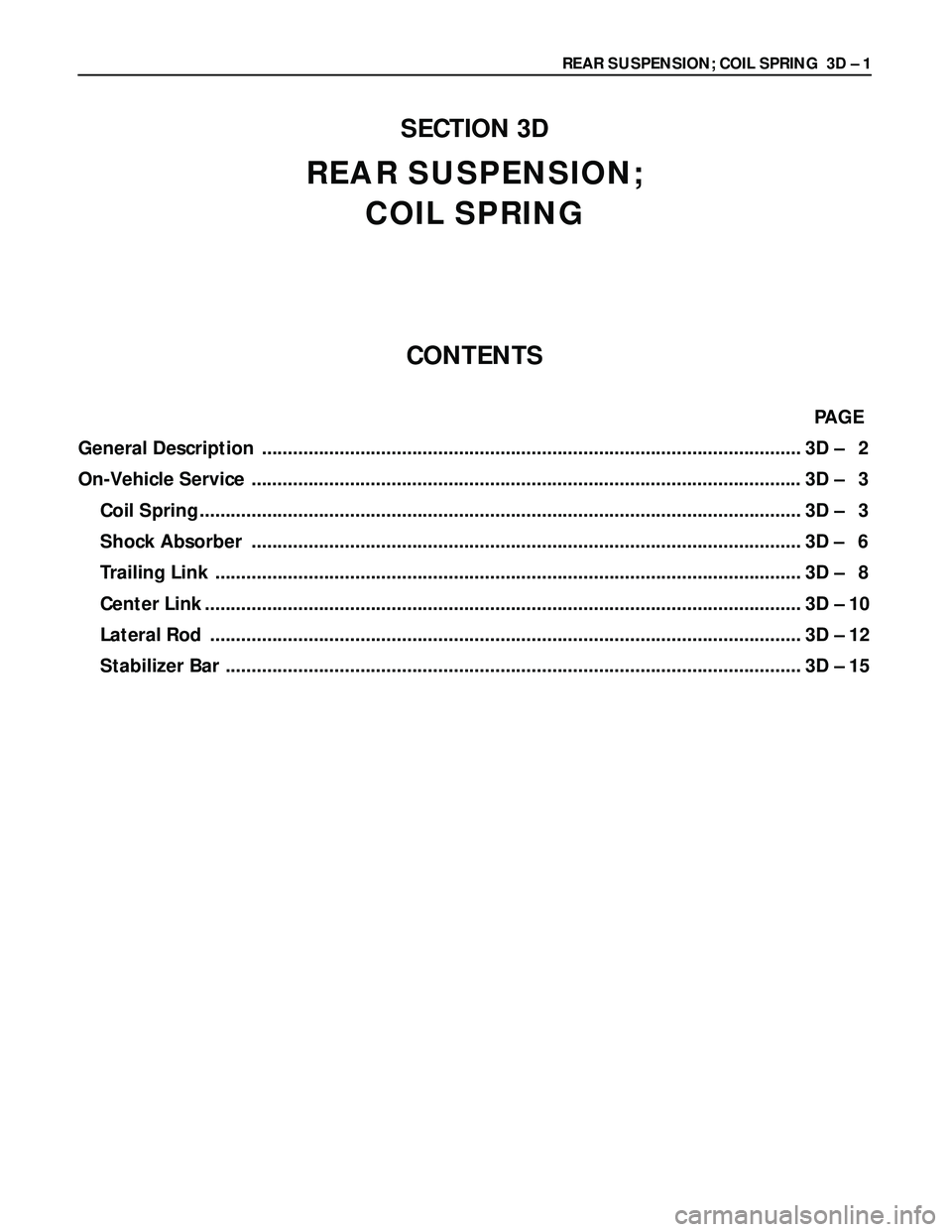
REAR SUSPENSION; COIL SPRING 3D – 1
SECTION 3D
REAR SUSPENSION;
COIL SPRING
CONTENTS
PAGE
General Description ........................................................................................................ 3D – 2
On-Vehicle Service .......................................................................................................... 3D – 3
Coil Spring ....................................................................................................................3D – 3
Shock Absorber .......................................................................................................... 3D – 6
Trailing Link .................................................................................................................3D – 8
Center Link ................................................................................................................... 3D – 10
Lateral Rod .................................................................................................................. 3D – 12
Stabilizer Bar ............................................................................................................... 3D – 15
Page 417 of 3573
3D – 2 REAR SUSPENSION; COIL SPRING
GENERAL DESCRIPTION
Stabilizer Bar
Center Link
Shock Absorber
Trailing LinkLateral Rod
The rear suspension is a 4-link, coil spring type
suspension with a stabilizer, consisting of two
trailing links, center link, lateral rod, shock
absorber, and stabilizer. In this suspension, the
links are specially arranged to enable the rear axle
to move freely, thereby expanding suspension
stroke, reducing friction, and improving lateral
rigidity and roll control. All these result in improved stability, riding comfort, and rough road
maneuverability.
Each link connects the axle housing with the frame
through a rubber bushing. The axle housing is
supported by the trailing links and center link
longitudinally and by the lateral rod latitudinally.
C03RW003
Page 418 of 3573
REAR SUSPENSION; COIL SPRING 3D – 3
ON-VEHICLE SERVICE
COIL SPRING
5
2
4
5
31
1
Removal Steps
1. Parking brake cable bracket
2. Stabilizer bar
3. Shock absorber
4. Insulator
5. Coil spring
Installation Steps
5. Coil spring
4. Insulator
3. Shock absorber
2. Stabilizer bar
1. Parking brake cable bracket
460RW024
Page 419 of 3573
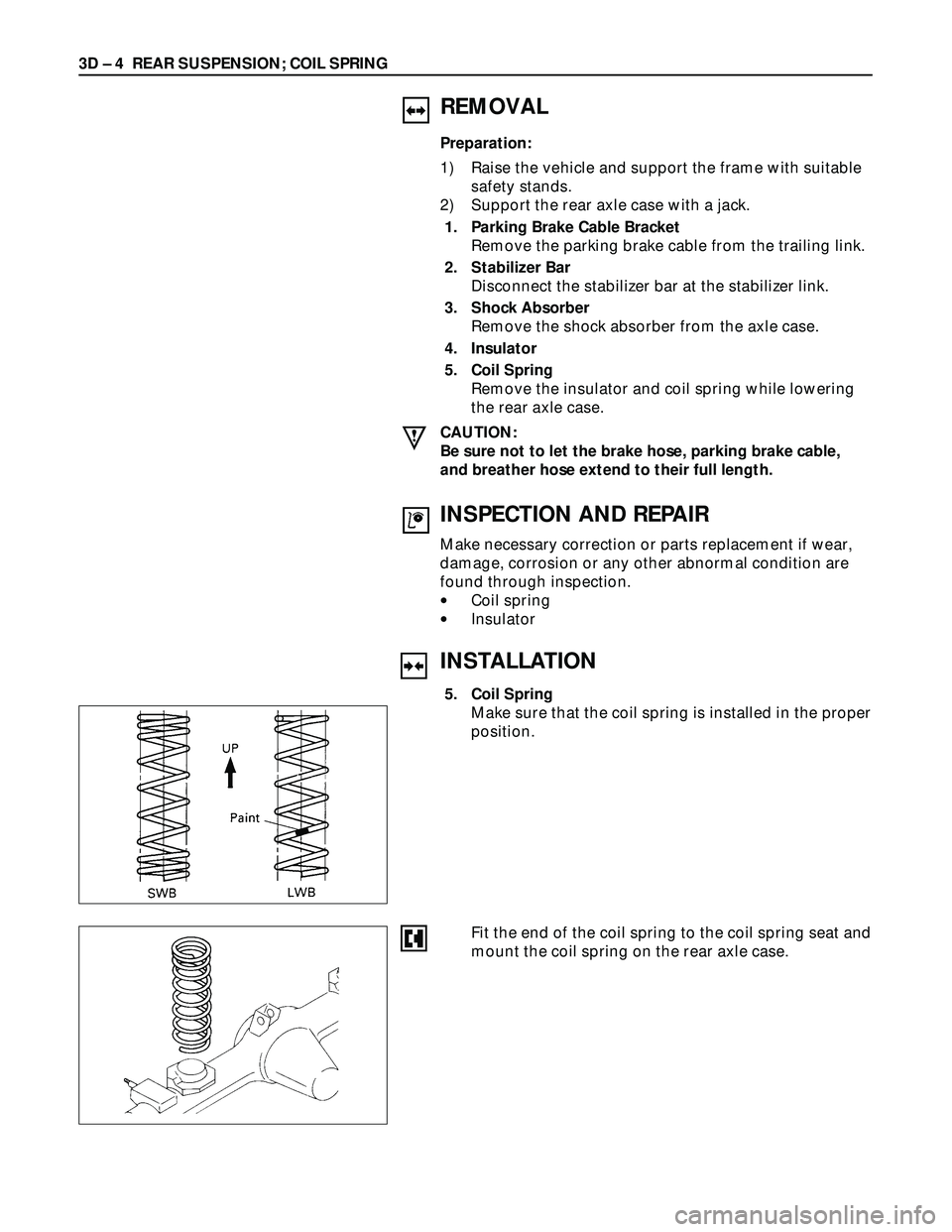
3D – 4 REAR SUSPENSION; COIL SPRING
INSTALLATION
5. Coil Spring
Make sure that the coil spring is installed in the proper
position.
REMOVAL
Preparation:
1) Raise the vehicle and support the frame with suitable
safety stands.
2) Support the rear axle case with a jack.
1. Parking Brake Cable Bracket
Remove the parking brake cable from the trailing link.
2. Stabilizer Bar
Disconnect the stabilizer bar at the stabilizer link.
3. Shock Absorber
Remove the shock absorber from the axle case.
4. Insulator
5. Coil Spring
Remove the insulator and coil spring while lowering
the rear axle case.
CAUTION:
Be sure not to let the brake hose, parking brake cable,
and breather hose extend to their full length.
INSPECTION AND REPAIR
Make necessary correction or parts replacement if wear,
damage, corrosion or any other abnormal condition are
found through inspection.
•Coil spring
•Insulator
Fit the end of the coil spring to the coil spring seat and
mount the coil spring on the rear axle case.
Page 420 of 3573
REAR SUSPENSION; COIL SPRING 3D – 5
4. Insulator
Install the insulator on the coil spring. Jack up the axle
case gently with the top of the coil spring to set the
spring seat on the frame side.
3. Shock Absorber
Tighten the nut lightly, and retighten to the specified
torque after the vehicle is at curb height.
NOTE:
When mounting shock absorber, be sure not to use
grease on bushings or any other nearby part.
Shock Absorber Nut Torque N·m (kg·m/lb·ft)
78 (8.0 / 58)
2. Stabilizer Bar
Stabilizer Bar Nut Torque N·m (kg·m/lb·ft)
50 (5.1 / 37)
1. Parking Brake Cable Bracket
Trending: odometer, park assist, drive shaft connection, rims, glove box, OBD port, start stop button
